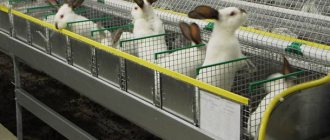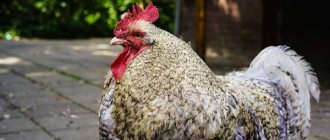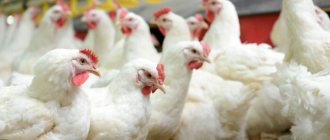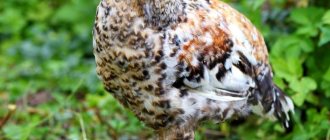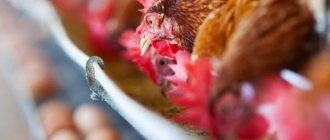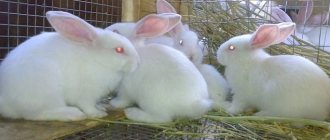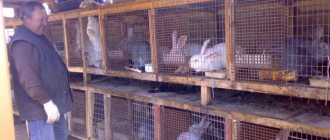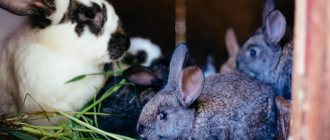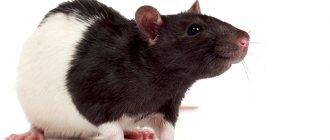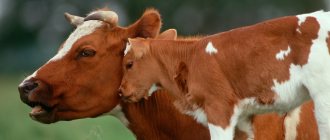Breeders of cute and fluffy animals should have reliable information about how much a rabbit weighs and when the animal gains the most weight. Such information will help determine the effectiveness of the selected food and the time when the rabbit will produce the largest amount of meat when slaughtered. It is worth noting that each breed of animal has an individual growth rate.
Average rabbit weight
Rabbits are a popular species of livestock, which farmers are happy to breed for their tasty meat and precious fur. Caring for and maintaining rabbits is much easier than large livestock, and thanks to their high fertility, fluffy bunnies calmly reproduce in captivity, bringing the desired offspring.
The approximate weight of a rabbit is about five kg, but, of course, there are also giant varieties whose weight reaches 8–9 kg. Slaughter weight differs from live weight by 30%, that is, if the animal weighed 10 kg before slaughter, then the final weight will be approximately 7–7.5 kg. The officially registered maximum weight of a rabbit is 25 kg.
In order to obtain meat products, breeders mainly keep representatives of large breed lines, which rapidly gain body weight, even if the animals’ diet consists of cheap feed.
How much do rabbits gain depending on age?
Rabbit farming is far from the last place in the livestock industry. Long-eared rodents are kept not only by owners of large complexes, but also by owners of summer cottages. Most modern breeds are unpretentious to living conditions, which makes rabbits very popular for breeding. The value of animals is represented not only by delicious meat products, but also by down and skins.
Each breeder is recommended to know how much weight a rabbit of a particular breed can gain by the time of slaughter, and for this it is necessary to become familiar with the characteristics of various animals, which will be discussed further.
Rabbit weight by month
Newborn rabbits are born blind, bald and tiny, but thanks to their mother's nutritious milk they quickly begin to recover. A month after birth, the baby rabbit’s mass multiplies tenfold. Then the growth rate decreases slightly. The average weight of a rabbit at 3 months of life is from 2 to 2.6 kg.
Animals reach sexual maturity at 5–6 months; during this time period, body weight reaches about 70% of the number of kilograms of an adult, and is approximately 3.5 kg. Rabbits reach their maximum weight after the first 10 months. The number of kilograms gained will depend on the breed line and feeding of the pet. Farmers need to know the developmental characteristics and growth rate of individual varieties in order to achieve the goal for which the animals were bred.
Soviet chinchilla
The average weight of a Soviet chinchilla is 6 kg. The maximum weight of rabbits is 8 kg. The minimum weight of rabbits and female rabbits is 4 kg. Purebred rabbits grow quickly and gain weight. By 3 months of age, the weight of animals is 3.5-4 kg. The slaughter yield of tender and tasty meat is 56%. It is sold even in large restaurant chains. During the birth, 7 rabbits are born. Deviations from this indicator are rarely observed.
The fur of the Soviet chinchilla is gray with a silver tint. In some cases, the coat has a dark gray color, close to a graphite shade, or light gray. The skin is of good quality, which allows it to be sold on the market. Externally, the hybrid looks like a gray giant.
The Soviet chinchilla has only one drawback: it is picky about food. Minor violations of the diet and the use of stale feed or products of average and low quality lead to the death of livestock.
Rabbit weight by breed
The determining factor in the final mass of an animal is its breed, since the growth rate, weight and productivity of the animal depend on it. All pedigree lines are divided into three varieties:
- Meat - representatives are bred only to obtain tasty and tasty meat. Rabbits are distinguished by good weight and well-developed muscles, the average weight is 7 kg.
- Downy rabbits are decorative rabbits that produce valuable fur. The weight of the animals is small - only 3-4 kg, so the breed is used only for the extraction of skins.
- Combined - representatives of the combined variety can boast of both respectable size and thick hair, so individuals are used as meat and down animals. The weight of the animals varies from five to six kg.
Each breed line has individual developmental characteristics that need to be studied in more detail.
Californian
The California rabbit belongs to large combined pedigree lines, as it demonstrates excellent performance in both fur and meat. The average weight of a rabbit is 4–5 kg; animals exceeding this mark are very rarely encountered. The animals reach their greatest mass in the first eight months of life.
Approximate growth of the Californian breed by month:
- first day - 50 g;
- 1 month — 1.7–2 kg;
- 3 months — 2.6 kg;
- 5 months — 3.5 kg;
- 6 months - 4.4 kg;
- 8 months — 5 kg.
New Zealand
Flemish and Belgian breeds were used to breed New Zealanders, and other varieties were later added. Due to the large mixture of different bloods, New Zealand rabbits were divided into two subspecies:
- Reds are animals with a chestnut-scarlet shade of fur and brown eyes. Average weight - 5 kg.
- White rabbits have a light milky hue and red eyes. Body weight - 4–4.7 kg.
Female representatives of this breed are distinguished by their considerable body weight - female rabbits are always more plump than males.
Weight gain indicators:
- newborns - 60 g;
- 1 month - 600 g;
- 3 months — 2.5 kg;
- 5 months — 3.5 kg;
- 7 months - 4.1 kg;
- 8 months - 4.3 kg.
Gray and white giant
Representatives of the pedigree of gray and white giants are distinguished from other breeds by their fatness, powerful limbs and straight back. The difference between the animals lies in the weight and color of the coat. Gray rabbits are similar in appearance to forest hares; adult individuals weigh from 4 to 7 kg. Their counterparts with light milky fur and scarlet eyes gain weight of 5–5.7 kg.
Giants are characterized by an excellent ability to increase the number - in one pregnancy, a female rabbit is able to reproduce up to fourteen small fluffy bunnies.
Mass gain rate:
- first day - 60 g;
- 30 days - 700 g;
- 90 days - 2.4 kg;
- 150 days - 4.1 kg;
- 240 days - 5.7 kg.
Risen
The Riesen, or German giant, is very popular among farmers due to its colossal size and powerful constitution. The animals have well-fed paws, long ears, and short dense hair. The color can be dark, bluish, smoky or snow-white.
The average weight of a Risen rabbit is from 7 to 10 kg, while the animals stand out for their clumsiness, enormous strength and calmness.
Weight indicators of German giants:
- newborns - 900 g;
- 30 days - 1.2 kg;
- 90 days - 5 kg;
- 7 months — 8.2 kg;
- 8 months - 9 kg.
Blue Royal Giant
Despite the sonorous name, the royal giant rabbit is inferior in size to the German and gray giant. The average body weight of animals is 4–5 kg. Royal giants have a well-proportioned body, covered with dense fur of a delicate gray-blue hue. Eye color - cornflower blue.
Weight indicators for this variety:
- first day - 70 g;
- 1 month - 500 g;
- 3 months — 2.1 kg;
- 5 months — 3.3 kg;
- 7 months — 4.2 kg;
- 8 months — 5 kg.
Flanders
Flanders rabbits are popular all over the world due to their cute face and funny appearance. The rabbit's ears are wide, its build is strong, with well-fed paws. The average weight of representatives is 7 kg, but there are individuals with a mass significantly exceeding this figure. For example, one of the Flanders rabbits weighed about 25 kg.
In addition to good meat yield, the breed has rapid weight gain:
- newborns - 60 g;
- 30 days - 800 g;
- 90 days - 2.7 kg;
- 210 days - 6.3 kg;
- 240 days - 7.1 kg.
Soviet chinchilla
The breed of Soviet chinchillas was bred by mixing the blood of snow-white giants and chinchilla rabbits, with an average weight of 4–6 kg. The main advantages of the representatives of the genus are a large yield of meat products, frost resistance, and unpretentiousness. In addition, Soviet chinchillas are distinguished by their thick, silky fur and strong build.
Weight gain indicators by month:
- newborns - 70 g;
- 2 months — 1.8 kg;
- 3 months — 2.7 kg;
- 5 months — 3.5 kg;
- 9 months - 5.2 kg.
Features of maintenance and care
It is more advisable to place rabbits of giant breeds in wooden cages, placing them in places protected from direct sunlight and drafts. The home should be spacious. Its dimensions are determined individually, taking into account the age and breed of the animal. To raise an adult giant, a cage with an area of at least 0.6 m2 (80×100×65 cm) is required; for a female rabbit with cubs, you will need an enclosure measuring at least 100×150×65 cm.
The cage must be spacious, clean, protected from adverse weather conditions
When preparing a home for rabbits, it is more practical to make the floor from a metal mesh, since it is practically not contaminated with feces, which ensures cleanliness and simplifies maintenance. But representatives of some giants, for example, white and gray, due to their large weight, have a predisposition to the appearance of corns and the occurrence of pododermatitis. Therefore, the flooring for each breed of rabbit is selected individually. The solid bottom should be covered with hay, straw or sawdust. The last option is the most preferable, since sawdust perfectly absorbs moisture and eliminates unpleasant odors.
There must be space in the cage for a feeder and drinking bowl, and a queen cell should be equipped for the female.
The mother liquor is necessary for breeding and milk feeding of baby rabbits up to an average of 1.5 months of age.
Representatives of breeds that are adapted to Russian climatic conditions and tolerate cold temperatures well can be kept outdoors all year round. However, in severe frost, it is better to bring the cages indoors, as there is a risk of frostbite to the extremities.
The following video will introduce you to an interesting way of equipping a cage for a large rabbit:
What can influence the rate of weight growth
The productivity of the farm directly depends on the rate at which the animals gain body weight. The growth characteristics of rabbits are determined by the following factors:
- breed;
- time of birth;
- quality of mother's milk;
- content;
- diet
There is a relationship between weight gain and the time of year in which the baby rabbit was born. Experienced farmers have noticed that if the birth occurred in winter or spring, then such rabbits will develop and grow much faster than summer and autumn rabbits.
The growth rate is also influenced by the conditions of detention and mother's milk, which sets the rate of development of the baby rabbit from the first days of life. The better quality and more nutritious it is, the faster the rabbit will grow. Representatives of the breeds gain maximum weight at 9–10 months and do not grow any further, so at this age only females and breeding males are left. The remaining rabbits go to slaughter.
Diet plays an important role - nutrition should be of high quality and balanced. Young and young animals are fed four times a day, and mature animals - 2 times a day. It is impossible to abruptly switch rabbits from four meals a day; portions should be gradually reduced until the amount is equal to two feedings per day. The diet must include the following products:
- corn;
- fresh cabbage leaves;
- vegetables;
- beans;
- vitamins and minerals.
By following the feeding regime and rules, you can achieve good growth and development even in those breeds that initially have a small body weight. Rabbits must be kept in warm and windless rooms to eliminate the risk of developing diseases, thinness, and poor health.
The weight of fluffy rabbits is largely determined by the breed line, but it should be remembered that under poor housing conditions and poor-quality feeding, even representatives of giant species will grow slowly. Therefore, in order to increase the productivity of rabbits, it is necessary to treat the nutrition and breeding of animals with attention and care, creating comfortable living conditions for the animals.
Methods of raising rabbits for meat
To obtain a large volume of tasty dietary rabbit meat, meat rabbits are raised that grow well and build muscle mass well: California New Zealand red New Zealand white Vienna blue White giant Poltava silver Belgian Gray giant Risen Rex Soviet chinchilla Butterfly Marder White pannon Black-brown Burgundy
Meat rabbits vary in meat fat content, productivity and taste characteristics. But each breeder selects these features individually in practice.
Broiler method of breeding rabbits
The essence of broiler breeding: the baby rabbits and the nursing rabbit live together until slaughter. Jigging is not expected. Early maturing breeds are grown in this way: White Pannon, New Zealand, Californian. After 3 months, young animals can be sent to slaughter.
Broiler feeding involves a properly selected diet with gradual changes:
- Stage 1 – “preparation” – introduction of high-calorie foods (concentrates) in an increased dose, while giving 50% less greens;
- Stage 2 – “main” – feeding with food high in fat for the formation of adipose tissue in eared animals;
The amount of fat should not be exceeded, as this can negatively affect the digestion of rabbits.
Stage 3 – “finishing” – introduction of the maximum volume of feed. To increase appetite, give salt water, dill, caraway seeds, parsley, celery.
| Positive aspects of the broiler method | Negative aspects of the technique |
| • Savings on the production of new cells. | • Negatively affects the health of female rabbits (a maximum of 2-3 litters per year are produced from one female, and then sent for culling). |
| • Eliminates the stress that animals experience during laying. | • It is necessary to strictly control the nutritional value of the diet of lactating females (insufficient consumption of necessary substances leads to rapid exhaustion). |
| • Ushastiki consume mother's milk before slaughter, which makes their meat more tasty and tender. |
Common method of fattening young rabbits
Fattening rabbits for meat in the traditional way involves weaning the babies at 2 months of age and feeding them nutritious food until slaughter. It is preferable to enrich the diet with corn cobs, bean straw, wheat and barley grain, and potatoes. It is better to prepare hay for fattening during the flowering period, when the grass has maximum nutritional value.
Record holders among long-eared animals
Ralph Rabbit's story is like a roller coaster. Paulina Grand's ward is considered the largest. But doctors are seriously concerned about the pet’s well-being. Today, the weight of the big-eared celebrity is 22 kg, although the owner assures that she provides the rabbit with physical exercise. However, the giant is outwardly active and does not show any dissatisfaction with its maintenance or care. The body length of the playful domestic hare is 130 cm.
Darius is another former Belgian breed record holder. In 2010, he even managed to dislodge Ralph, however, after that he lost ground with a weight of 19 kg. His owner, Annette Edwards, had previously registered large rabbits in the Book of Records; they were the parents of Darius. Apparently, the hereditary factor played a huge role in this particular case. The length of the body in 2010 was inferior to the current leader. True, according to some reports, the pet will soon snatch the palm from Ralph again. The owner claims that the rabbit gained weight - 22.2 kg and grew to 130 cm.
Jeff is the son of Darius, so it is not surprising that the whole world expects big victories from him. Annette, as a specialist in breeding ornamental breeds, is confident that Jeff will become a record holder. Now the rabbit is 3 years old, but its body length is already 95 cm. Miss Edwards is happy to tell the secret of such success in an interview. First of all, this is a balanced diet, as well as physical exercise. For example, Darius’s weight, as Annette admits, is largely determined by muscles. He is very active, runs constantly, and his caring owner spends the lion's share of her financial resources on quality maintenance. The price of good food for large breeds is high, which forces the farmer to turn to relatives for help.
How old is a dog by human standards?
When to slaughter
If we talk about the timing of slaughter, then it all depends on the purpose of breeding animals. To obtain tender meat products, animals go under the knife as soon as they reach the desired weight. And if the goal is to obtain meat and good skin, then you need to take into account some points. It all depends on the time of molting. In case of untimely slaughter, the resulting skin products are of poor quality, and over time the skin will simply become bald.
To choose the most optimal slaughter time, you can use the following recommendations:
- young animals born in winter are slaughtered on day 120;
- In young animals born in summer, molting ends in November;
- after vaccinations, animals are sent to slaughter only a month later;
- most breeds are slaughtered when they reach a weight of 1.6 kg;
- The best time to score is from November to March.
We invite you to join our Zen channel and group on VKontakte or Odnoklassniki, where new articles are published, as well as news for gardeners and livestock breeders.
Similar articles:
- Breed overview: Russian ermine rabbit
- Coniferous branches in the winter diet of rabbits
- Should you give zucchini to rabbits?
New Zealanders
Many farmers also know how much a rabbit of this breed weighs - along with the Californian, the New Zealand rabbit is the most actively bred in our area. On average, live weight is up to 5 kg, the body length reaches half a meter. Distinctive features of the structure are a cylindrical compact body, a wide back, rich in meat. Particularly vigorous growth is observed at an early age. The females of this breed are very fertile and milk-producing; one litter gives the farmer up to 8 young rabbits.
Industrial rearing of the New Zealand breed of rabbit allows us to obtain meat of impeccable quality. The muscles are predominantly located near the spine, the ribs are rounded, and the shoulder blades are quite large. The muscle fibers on the lower back and sides are the most dense, although throughout the body the density is sufficient to indicate high quality. The yield per rabbit is up to 60%.
Belgian Flanders
This is a breed of giant rabbits, the distinctive features of which are an insatiable appetite and rich fluffy fur. However, despite their love for food, rabbits are extremely picky in their choice. On average, the weight of an individual reaches 12 kg, the body grows up to a meter in length, and the length of the ears is almost 20 cm.
Due to their impressive size, rabbits are considered profitable for farm breeding, as they produce a lot of meat. However, there are also weaknesses. For example, female rabbits produce offspring, although numerous, much later than many other varieties. The Belgian Flanders' coat comes in a variety of shades of gray. It is often used to imitate expensive fur.
Where to get it?
Indeed, having found out all the benefits of rabbit meat, everyone will want to know where to get such a unique product for their table. Owners of rabbit farms are sure: you need to buy from them. In total, about two hundred species of animals are known, but not all are meat. Most of the known rabbits provide tasty meat and beautiful skins, but some are too small to be used for food.
The most delicious and healthy meat can be obtained from a meat breed. There are several of the most popular rabbits currently being bred on farms. They are the ones on sale.
Is it worth starting a business?
Breeding giants is considered a promising area for business, but novice farmers admit that the task is not an easy one. Rabbits live in cages, so it is necessary to choose a spacious structure inside which the individual can rise on its hind legs. Having free space is one of the most important conditions for the quality growth of any breed.
To make the rabbit comfortable, the floor of the cage is covered with sawdust, straw, and hay. From time to time you need to add fruit branches so that the rabbit can gnaw on a hard object. To regularly feed the animal, it is necessary to provide a feeder and a large drinking bowl. The fluid is changed daily - this is the key to the health of the individuals. Bowls for rabbits are more suitable for heavy ones, as the animals can turn them with their nose.
In order for the female to give a normal birth, one of the corners must be equipped with a heating system - this is what she will choose for giving birth. The fertility of modern breeds is quite high, birth control is not required, and small cubs at birth weigh no more than one hundred grams, but their number often reaches 7, and sometimes more. In just a month and a half, the weight of the young animals will increase to one and a half kilograms. To avoid diseases, it is necessary to keep the cage clean - bacteria are dangerous not only for people, but also for rabbits.
What determines quality weight gain?
Farm productivity is directly related to the rate at which the animals gain weight. This component of success can be influenced by taking into account the following parameters:
- natural characteristics of the breed;
- hereditary qualities of the livestock;
- maternal qualities of the female;
- living conditions created for animals;
- quality and diet;
- properly conducted perinatal and infant periods.
When planning farming activities, the owner needs to decide for what purpose the rabbits will be raised. If the direction of farming is only meat, meat types of animals are needed.
If a farmer plans to produce meat and skins, then the livestock for breeding must be selected accordingly. Giant breed rabbits show the best weight gain results at minimal cost.
What is required to open a slaughterhouse?
First, you will need to purchase all the necessary equipment. This includes electric saws, hoists and blocks for lifting carcasses, freezers for storing finished products. For cutting you need to purchase a set of knives, cleavers and axes.
Employees should purchase special clothing and shoes. Please note that a cattle slaughterhouse requires the involvement of only professional butchers who can quickly and accurately cut even large volumes of meat.
Equipment costs will be at least 2-3 million rubles. The main expense item is freezers, the cost of which is quite high.

